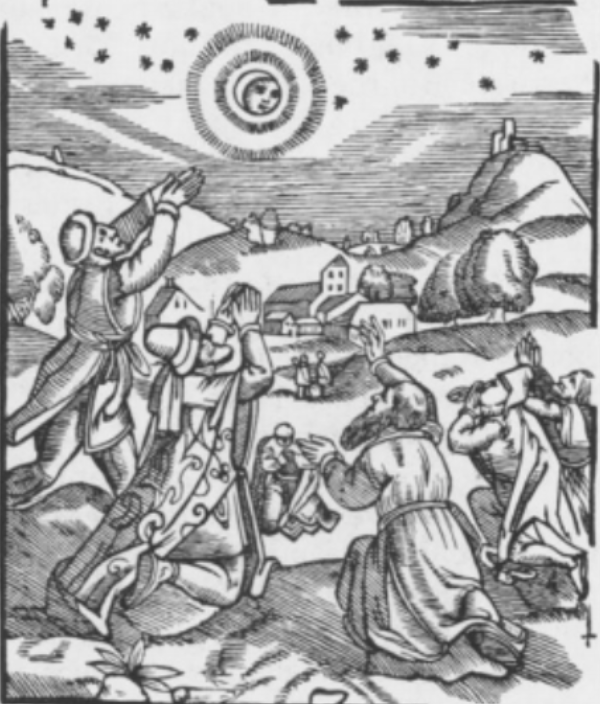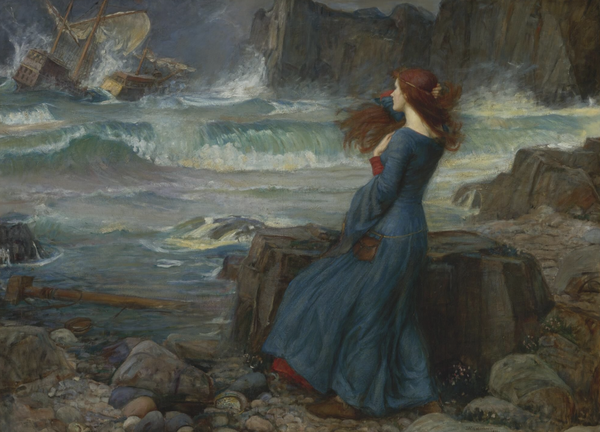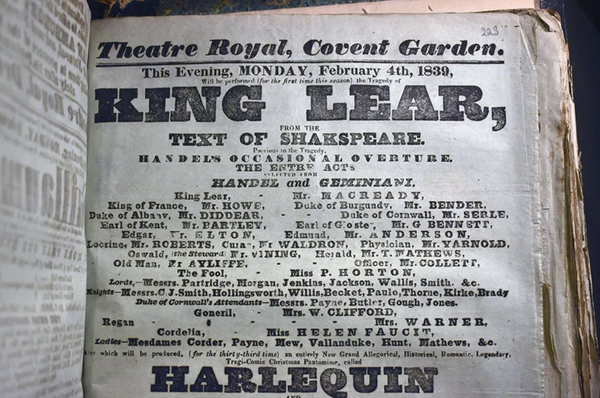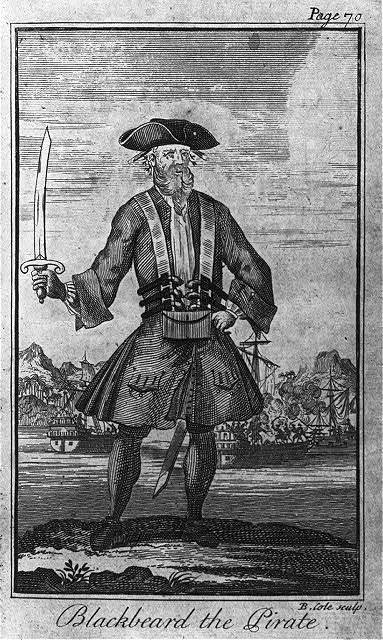Volume 22: March 11, 2021
Followers of the Man in the Moon
By London Johns
When the players in A Midsummer Night’s Dream consider what characters are required to tell the story of “Pyramus and Thisbe”, they decide that since the story takes place under the light of the moon, they must assign a player to portray moonlight. With a lantern, a bundle of sticks, and a dog, Robin Starveling becomes the character “Moonshine,” or “the man i’th’ moon” (Shakespeare, A Midsummer Night’s Dream 5.1.259). Moonshine’s dog and bundle of sticks are references to folktales about the Man in the Moon throughout the Middle Ages. Although Shakespeare’s references to the story of the Man in the Moon rely on his audience’s understanding of folklore, the folktales that Shakespeare would have been familiar with were much graver than Starveling’s comical performance suggests.
In European tales, the Man in the Moon never originated on the moon, but was sent there after committing a crime. Various versions of the story included that he was a thief, was caught red-handed, and was banished to the moon to forever carry what he stole as punishment, whether it be a bundle of sticks or vegetables. These stories were used as cautionary tales about theft:
“See the rustic in the Moon,
How his bundle weighs him down;
Thus his sticks the truth reveal
It never profits man to steal.” (Baring-Gould 196)
Christian versions of this story replaced the thief with someone who broke the Sabbath or prevented others from attending church. In some stories, the Man in the Moon was said to be a man stoned to death for collecting sticks on the Sabbath, hence the Man in the Moon’s bundle of sticks (Reiss 483). Other stories connected him to Cain, though this belief is less well documented; most famously, Dante refers to the moon as “Cain with fork of thorns” (20.123). In this version of the folktale, Cain was banished to the moon as punishment for Abel’s murder, cursed to eternally carry a bundle of sharp thorns (Leland 226). The stories told about how the Man in the Moon became trapped there shared one similarity: in each, his confinement was a never-ending punishment.
None of these iterations of the story of the Man in the Moon mentioned a dog condemned to the moon alongside him, but the Man in the Moon’s dog was also a recurring aspect of the tale, though less common than his thorn-bush. A 1335 seal on a deed includes the Man in the Moon with his typical bundle of thorns and accompanied by a small dog. Along the edge of the seal, a legend reads, “Te Waltere docebo cur spinas phebo gero” — “I will teach thee, Walter, why I carry thorns in the moon” (Baring-Gould 199). The origin of the Man in the Moon’s dog is unclear, and its presence in the story varied from place to place; in some areas, instead of a dog, the man was said to be accompanied by a woman eternally making butter (Baring-Gould 200). Though the Man in the Moon’s dog was not frequently included whenever he appeared in visual art or literature, it may have been a more common aspect of tales told aloud. Shakespeare seemed to identify it as an central characteristic of the Man in the Moon; a dog is mentioned alongside the man not only in A Midsummer Night’s Dream but in The Tempest, when Stephano tells Caliban that he is “the man i’ th’ moon” and Caliban replies that he has seen “thee, and thy dog, and thy bush” (Shakespeare, The Tempest 2.2.144-146).
This moment in The Tempest draws from another legend about the Man in the Moon: that he was a symbol for those who were frequently intoxicated. As Raymond A. Urban noted in his interpretation of this scene, the moon became the companion of people drinking at night because as the moon rose, the Man in the Moon’s face appeared red as if he was drunk (Urban 205). A ballad from the late 17th century contained the following verse:
“The Plummer will dine at the Fountain,
The Cooks at the holy Lamb:
The Drunkards at Noon to the Man in the moon,
And the Cuckolds to the Ram" (Urban 204).
In this case, the ballad’s drunkards could literally go to the Man in the Moon to drink: “Man in the Moon” was the name of three different pubs in London at the time (Urban 204). Another ballad, called “The Man in the Moon Drinks Clarret”, recognizes the symbolic rather than literal significance of the Man in the Moon:
“Our man in the Moon drinks Claret,
With Powder béef turnep and Carret,
If he doth so why should not you
Drink wine untill the Sky looks blew” (“The man in the moon drinks…”).
An accompanying woodcut shows a group of men kneeling and praying to the moon for more liquor, suggesting that the Man in the Moon was regarded as more than just a representation of a drunk man, but as a kind of patron saint. The men’s worship of the moon is similar to how Caliban reacts to receiving a bottle from Stephano: “That’s a brave god and bears celestial liquor. I will kneel to him.” (Shakespeare, The Tempest 2.2.121)
This satirical application of religious rituals to gods of alcohol was not just hyperbole. A ritual took place in some medieval bars to indoctrinate patrons into the cult of Bacchus, the Roman God of wine. In a late 16th-century broadside ballad called “Bacchus his Bountie”, a man named “Tom Typsay” falls to his knees, holds his hands to the sky, and prays to Bacchus: “Water to drinke, I hold not good,/Thy Juice, Oh Bacchvs, breeds best Blood” (Oldys 288). His declaration that he does not want to drink water is an interesting detail; a popular, though disputed, belief holds that people living in the Middle Ages and Renaissance often drank ale to avoid consuming unsafe water. If so, Typsay’s pledge could be in his own best interests. Like Caliban believing Stephano’s bottle must be celestial, “Tom Typsay'' believes that his liquor is so great it must come directly from a god. Stephano instructs both Trinculo and Caliban to “kiss the book,” another parody of real religious practices. In Rabelais’s Panurge, the priestess of a Bacchic temple gives an inductee a bottle and tells them to “taste its chapters” and “swallow down its texts” (qtd. in Urban 205). By using the same language as in real rituals, Stephano giving Caliban his drink and naming himself the Man in the Moon becomes more than just a joke. Stephano successfully initiates Caliban into a bizarre, satirical religion. Where the tale of the Man in the Moon is mentioned in Shakespeare, it is used for comedic purposes. Starveling appears as Moonshine and is relentlessly mocked for his performance: Hippolyta declares, “I am aweary of this moon. Would he would change.” (Shakespeare, A Midsummer Night’s Dream 5.1.265) Similarly, the comedy in Act II Scene II of The Tempest arises from Caliban’s adoration and Stephano and Trinculo’s banter. It is only beneath the surface that darker elements of these folktales can be seen. What seems at first to be simply a joke at Caliban’s expense connects him to myths about unceasing servitude and punishment: servitude to Bacchus and the Man in the Moon, punishment in the form of isolation and an eternal burden. Caliban, trapped alone on an island for most of his life and forced to endure Prospero’s cruelty, follows the model of the Man in the Moon in more ways than one.
Works Cited
Alighieri, Dante. Dante's Inferno. Edited by Gustave Doré. Translated by Henry Francis Cary, Cassell, Petter, Galpin & Co., 1866, Internet Archive, archive.org/details/dantesinferno00dantuoft/.
Baring-Gould, Sabine. Curious Myths of the Middle Ages. Rivingtons, 1876, Internet Archive, archive.org/details/curiousmythsofmi00bariuoft/.
Driver, Martha W., and Sid Ray. Shakespeare and the Middle Ages: Essays on the Performance and Adaptation of the Plays with Medieval Sources or Settings. McFarland, 2014, Google Books, https://books.google.com/books?id=Z36yCwdHQzoC
Leland, Charles Godfrey. Legends of Florence. Macmillan and Co., 1895, Google Books, books.google.com/books?id=2jXwDQfGqiQC
Oldys, William. The Harleian Miscellany : or, A Collection of Scarce, Curious, and Entertaining Pamphlets and Tracts, as Well in Manuscript as in Print. vol. 2 12, Printed for T. Osborne, 1744, Internet Archive, archive.org/details/harleianmiscella02oldyiala/.
Reiss, Edmund. “Chaucer's Friar and the Man in the Moon.” The Journal of English and Germanic Philology, vol. 62, no. 3, 1963, pp. 481–485. JSTOR, www.jstor.org/stable/27714293. Accessed 9 Mar. 2021.
Shakespeare, William. A Midsummer Night’s Dream. Edited by Barbara Mowat and Paul Werstine, Folger Shakespeare Library, The Folger Shakespeare, shakespeare.folger.edu/.
Shakespeare, William. The Tempest. Edited by Barbara Mowat and Paul Werstine, Folger Shakespeare Library, The Folger Shakespeare, shakespeare.folger.edu/.
“The man in the moon drinks claret, as it was lately sung at the Curtain Holy wel to the same tune.” London: Printed for F. Coles, T. Vere, and VV Gilbertson, between 1658 and 1664; Ann Arbor: Text Creation Partnership. http://name.umdl.umich.edu/B04453.0001.001.
Urban, Raymond A. “Why Caliban Worships the Man in the Moon.” Shakespeare Quarterly, vol. 27, no. 2, 1976, pp. 203–205. JSTOR, www.jstor.org/stable/2869029. Accessed 9 Mar. 2021.







